
Wingnut Wings 1/32 Sopwith Pup
| KIT #: | 32016 |
| PRICE: | $59.00 MSRP |
| DECALS: | Six options |
| REVIEWER: | Dan Lee |
| NOTES: | New Kit |

| HISTORY |
The Sopwith Pup (or
Scout as it was supposed to be known as) was based on Sopwith Test Pilot Harry
Hawkerís chalk outline of a single engine scout.
This later became known as Admiralty Type 9901 and eventually called the
Pup by everyone except military bureaucrats because of itís size compared to the
Sopwith 1 1/2 Strutter Observation Plane/Bomber.
The Pup was a light
and maneuverable fighter armed with a single Vickers machine gun
but matched up well against the heavier and more heavily armed Albatros,
Halberstadt and Fokker biplanes of the time and helped the Allies keep air
superiority till the
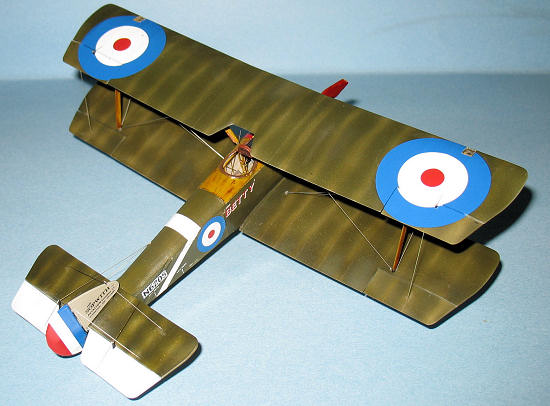 effects of vastly better Albatros DIIIs and German air
tactics led to Bloody April 1917.
Pups served with the RNAS from Mid 1916 till early 1917 when they were replaced
by the Sopwith Triplane and in the RFC from mid 1916 to Dec 1917 when Camels
finally replaced the last active duty Pups which were used in home defense units
to protect England against Gotha Bombers and Zeppelins.
Pups were used in training squadrons till the end of the war.
effects of vastly better Albatros DIIIs and German air
tactics led to Bloody April 1917.
Pups served with the RNAS from Mid 1916 till early 1917 when they were replaced
by the Sopwith Triplane and in the RFC from mid 1916 to Dec 1917 when Camels
finally replaced the last active duty Pups which were used in home defense units
to protect England against Gotha Bombers and Zeppelins.
Pups were used in training squadrons till the end of the war.
What is surprising
to me is at the peak of its wartime service, the Pup only equipped a mere seven
squadrons (four in the RNAS and three in the RFC.)
Due to its light
weight, the Pup became the first ever carrier aircraft as the Royal Navy
developed the means to fly planes off ships.
In 1917, Squadron Commander Edward Dunning became the first man to ever
land on the deck of a moving ship, the HMS Furious and several days later became
the first man killed in a carrier landing when his plane fell over the side
during a landing attempt.
The Pup also served
with the Americans, Greeks, Russians, Dutch, Romanians, Australians and notably
with the Imperial Japanese Army Air Force, who promptly fell in love with its
maneuverability.
Info from Wikipedia and the Wingnut Wings Instructions
| THE KIT |
See my
preview of
the Sopwith Pup Kit
| CONSTRUCTION |
 I actually started
building the La
I actually started
building the La
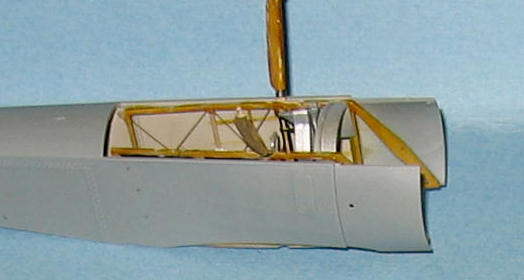 Next I worked on
the cockpit. Due to the wooden
frame construction of WW1 biplane cockpits, this was not a quick and easy task
(for any biplane model I might add.)
I sprayed the wooden parts Tamiya Buff to provide a base color for the
wood and the canvas was painted using Tamiya Deck Tan (as suggested in the color
guide) while the metal parts were done with Tamiya Chrome Silver as the base and
Talon Aluminum as the top coat.
Next I worked on
the cockpit. Due to the wooden
frame construction of WW1 biplane cockpits, this was not a quick and easy task
(for any biplane model I might add.)
I sprayed the wooden parts Tamiya Buff to provide a base color for the
wood and the canvas was painted using Tamiya Deck Tan (as suggested in the color
guide) while the metal parts were done with Tamiya Chrome Silver as the base and
Talon Aluminum as the top coat.
I didnít spend too
much time with dry brushing the wood effect on the interior bits, but I did
enough to it sort of show without putting too much effort into it.
I took more effort with the interplane struts and props because they
would be very visible. One thing I
tried to do was vary wood grain patterns instead of making them uniform.
 The real prop is a
laminate of wood, but I couldnít get that right with the brushes I have so I did
what I could.
The real prop is a
laminate of wood, but I couldnít get that right with the brushes I have so I did
what I could.
The instructions
mention various parts were light wood and dark wood.
What I did was brush clear yellow over the base paint layer for the light
wood and two layers of red clear and one layer of yellow clear for the dark
wood. The reasoning behind that was
due to trial and error. I found
that clear red by itself was too red while a one to one ratio of red/yellow made
it orange while the two red to one yellow ratio appeared just right to me.
It was easier than trying to mix and match different colors of wood for
the base color.
Next I assembled,
painted and decaled the cockpit plastic and PE seatbelt parts following the well
done instructions. I cut and glued
in some fishing line represent the control wires while I used brass wire for the
bracing wires between the frames using the information found in the
instructions. I found this assembly
to be a bit fiddly and had a bit of a hard time trying to get that to fit in the
fuselage. Take your time with it
and be gentle as the cockpit assembly is rather delicate.
One thing I should warn you about is that if you do make the control
wires is that you keep them as close to the floor as possible or the seat will
not fit well as I discovered when it would not stay secured to the frame.
I ended up having to cut some flat toothpicks to help raise the seat
enough off the ground so that the seat would stay on the frame but not be too
obvious to anyone peering into the cockpit.
I glued the fuselage halves together with the cockpit. Again take your time as the various parts need some coaxing. After a week to allow for outgassing, the fuselage seams were filled with CA glue and carefully sanded so as not to removed the fabric detail.
| COLORS & MARKINGS |
Painting
Note:
I painted the sub assemblies before I put the thing together.
The wings were
preshaded using white and/or Tamiya Deck Tan on the areas of the wing that were
on the wing ribs and flat black between the ribs.
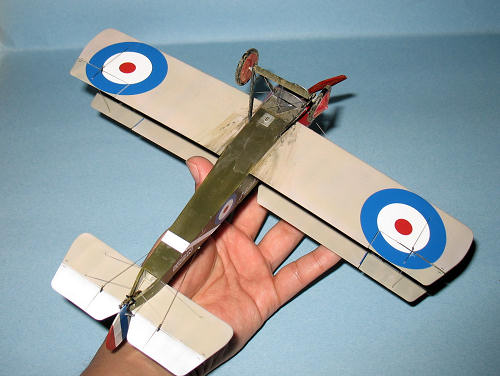 I started with the
ailerons and painted them white on both the top and bottom.
Once dry, I masked them off in preparation for the base color.
I started with the
ailerons and painted them white on both the top and bottom.
Once dry, I masked them off in preparation for the base color.
Apparently, Sopwith
had their proprietary version of Khaki which was fairly close to Tamiya OD
(FS34079) XF-62 instead of PC10. I
decided to take the path of least effort and I used XF-62.
I sprayed on two light coats so that the preshading could show through.
Looking back I think I may have over done the wing effect in comparison
to real life. I like how it turned
out though. The underside was
painted Tamiya Deck Tan which looks like the clear doped tan from the color
photos provided in the instructions.
I did the same for
the underside although I think I may have made a mistake with the underside
fuselage color as I went with Tamiya OD instead of Doped Linen.
It was hard to say as the paint guide didnít say one way or another.
Decals
Wingnutís decals
are made by Cartograph. They go on
very well using MicroSet and Solvaset for the difficult areas.
They provide six options all from the RNAS, but I selected the plane from
the cover, Betty. Wingnuts provides
a choice between a Red Betty or Black Betty.
Despite the fact that I like the song Black Betty, I prefer the Red Betty
markings. Note:
the decals were done after the sub assemblies were glued together.
It is the little
details that make things much easier.
Wingnuts makes a four part decal fuselage stripe that fits perfectly
rather than trying to fight a one or two piece decal stripe made easier due to
the box fuselage. The upper wing
roundels on the real plane
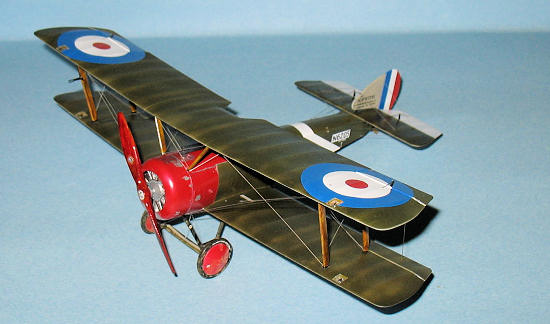 were painted into the gap between the wing and flaps,
but Wingnuts was thoughtful enough to provide a guide on the decal sheet to help
to place them on the wing to create that effect.
were painted into the gap between the wing and flaps,
but Wingnuts was thoughtful enough to provide a guide on the decal sheet to help
to place them on the wing to create that effect.
I used MicroSol on
the decals and a little bit of SolvaSet for the problem areas.
Weathering
This was actually
done when the plane was completed.
I kept the topside weathering to a minimum.
The underside was another matter altogether.
The engines of WW1 airplanes sprayed a lot of oil so I spent a lot of
time trying to make oil leaks and exhaust stains on the underside.
I used a combination of brush painted Tamiya Smoke (oil stains), a water
color wash and the Tamiya weathering set (exhaust stains) for the underside
while I used a sludge of Tamiya Desert Yellow and watercolors (burnt sienna,
black and raw umber) to represent mud on the tires and undercarriage.
Topside I added
some black pastel for the gunfire residue and added some Tamiya Smoke with a
fine tipped brush for the fuel stains.
It was all sealed in with a final coat of Future and then the absolute last final coat was Xtracrylic Satin Coat in random places.
| FINAL CONSTRUCTION |
There was a slight
gap between the lower wing and fuselage after I put them together.
Itís not really a problem if one uses Mr Surfacer or Vallejo Acrylic
Putty to fill the gap and then let it sit for a few minutes before removing the
excess with Q-Tips slightly damp with lacquer thinner or water.
Of course, I ended up painting the affected area again.
The Vickers Machine
gun was cleaned up, the photo etch parts were added then painted flat black and
dry brushed with steel. The
windscreen frame was painted burnt sienna to represent the leather.
 ďBettyĒ had an
aluminum cowling covered with red chipped paint so the various cowling parts
were masked off and painted. I
first painted all the exposed metal parts with Tamiya TS-30 Old Silver because
it was durable and would not react with the top coat acrylic paint.
Next I sprayed gloss Red, let it dry for about five minutes and took low
tack tape to the red to create the chipped paint look.
ďBettyĒ had an
aluminum cowling covered with red chipped paint so the various cowling parts
were masked off and painted. I
first painted all the exposed metal parts with Tamiya TS-30 Old Silver because
it was durable and would not react with the top coat acrylic paint.
Next I sprayed gloss Red, let it dry for about five minutes and took low
tack tape to the red to create the chipped paint look.
The top of the
cockpit section was painted Tamiya Deck Tan, burnt sienna was dry brushed on to
give it a wood look then it was sprayed with two thin coats of Tamiya clear
yellow. Once dry it was glued on
and then held together with C-Clamps till the glue fully cured so as to
eliminate any gaps.
Next I worked on
the landing gear. All the parts
were pre painted as per the instructions before assembly and then glued
together. If there is one area of a
WW1 biplane model I have consistent trouble with then it would have be the
landing gear. I have had issues
getting the damned things to align correctly and not wonky as it usually
happens. The Wingnuts landing gear
is designed well enough that even I can assemble a non wonky landing gear.
One thing I did find was that one tab was slightly higher than the slot
it was supposed to fit into so I trimmed it.
After that I glued
on the struts and the upper wing.
Again, I have to say that I am very impressed how the Wingnuts model design team
put it together as I had no issues with this part of the assembly unlike every
other WW1 biplane Iíve put together.
One last area that
needed to be fixed was the seam between the wing and fuselage which is not there
on the original (the underside is one long piece of fabric.)
I masked off the wings with painterís tape so as not to let the paint be
ruined by sloppy sanding. There is
a way to do it without filling and sanding, but I could not find the article and
went with the old painful way of filling/sanding instead.
Once done, the affected areas were masked off and painted Tamiya OD.
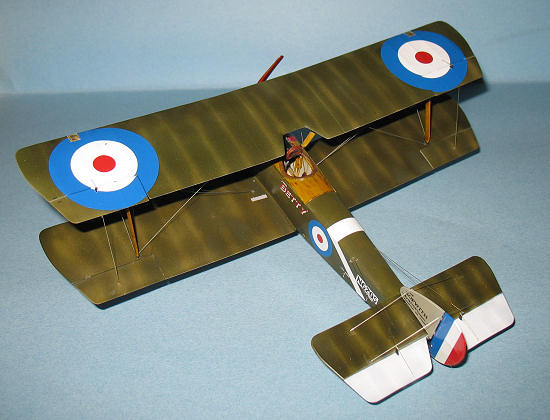 The rest of the
bits including the cowling, prop and machine gun were glued on at this time.
The rest of the
bits including the cowling, prop and machine gun were glued on at this time.
Rigging a Sopwith
Product is never fun because there is soooooo much of it.
I took about three days to complete the rigging using compass dividers to
mark out lengths between holes and using RB Productions PE British 4BA and 2BA
wires (based on a suggestion by Tom Cleaver) for the places that had the foil
wires. FYI, the sections that
require double wires were the worst.
I stuck with my old method of using white glue to secure metal wire
rigging and am happy to say that these worked out great.
One thing I wished that Wingnuts provided was to indicate which wires
used 4BA and 2BA. I took an
educated guess as to where it was and left it at that.
Note:
I also bought some of RB Productionsí 1/32 scale attachment points, but I
realized I donít have the patience to make some 50+ attachment points and didnít
do it. Maybe next time.
The control wires
were done with 0.08 inch diameter brass wire.
One hint to make
rigging easier. Work from the
inside out. What I mean is do all
the fuselage bracing wires first, next the wires between the struts that are
parallel to the fuselage and then do the wires between the wings that are
perpendicular to the fuselage. Any
other order will make things painful as you knock over wires or canít put the
wires in because the previous wires get in your way.
| CONCLUSIONS |
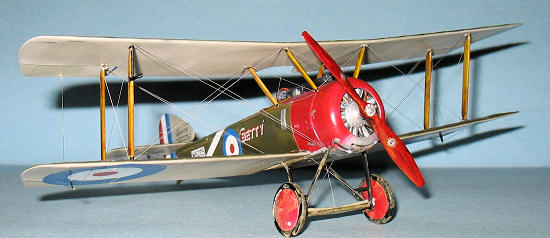 Iím impressed with
everything about this kit from the quality of the box art, parts and right to
the instructions. Wingnut Wingsí
owner Peter Jackson got more of my money as I ordered more of these kits as Iíve
been told that the free shipping from New Zealand (!) is still on.
Iím impressed with
everything about this kit from the quality of the box art, parts and right to
the instructions. Wingnut Wingsí
owner Peter Jackson got more of my money as I ordered more of these kits as Iíve
been told that the free shipping from New Zealand (!) is still on.
If youíve always
wanted to build a WW1 plane then Iíd strongly consider getting a Wingnut Wings
kit. These models are amazing well
done pieces of plastic and well worth the money in my opinion.
I canít say enough about how much I really like these kits.
If you want to
purchase a Wingnuts kit then you will have to go to their website:
Kit courtesy of my
wallet. Besides owning a set of the
LOTR DVDs, I have no connection to Peter Jackson or Wingnut Wings.
If you would like your product reviewed fairly and quickly, please contact me or see other details in the Note to Contributors.